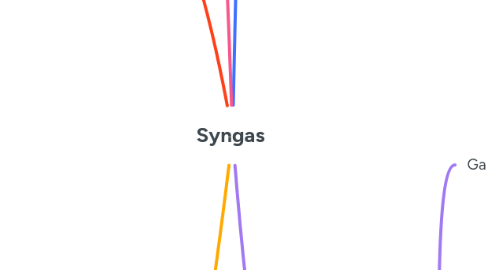
1. Properties
1.1. Flammability limits
1.1.1. range of the fuel concentrations in the fuel/air mixture at certain temperature and pressure, which allow the ignition of the flame to propagate and sustain the flammability limits
1.2. Laminar flame velocity
1.2.1. The laminar flash speed is the speed at which the flame propagates in the direction of expansion wave surfaces under a laminar flow condition via quiet unbranded fuel-oxidant mixes
1.2.2. Factors that affect it
1.2.2.1. composition of the fuel
1.2.2.2. mixture equivalence ratio
1.2.2.3. temperature
1.2.2.4. pressure
1.3. Factors that the composition depends on
1.3.1. feedstock
1.3.2. particulate size
1.3.3. gas flow rateand feedstock flow
1.3.4. chemical reactor configurations
1.3.5. operating conditions or process of gasification
1.3.6. gasificator and catalyst
1.3.7. gas residence time
2. Production
2.1. Gasification
2.1.1. All hydrocarbon feed resources like coal, heavy oils, or combustible biomass can be gasified as synthesis gas.
2.1.2. Biomass+O2→ CO+H2+CO2+H2O+CH4. By-products: tar, char, ashes. Reaction conditions: High temperature (800–1000°C) and low pressure (1–20 bar)
2.1.3. Efficiencies in gasification are based on
2.1.3.1. biomass type used
2.1.3.2. particle size
2.1.3.3. ER value
2.1.3.4. reactor design
2.1.3.5. lower heating value
2.1.3.6. ηm=Hg×QgHs×Ms×100. where ηm is the gasification efficiency (%) (mechanical), Hg is the heating value of the gas (kJ/m3), Qg is the volume flow of gas (m3/s), Hs is the lower heating value of gasifier fuel (kJ/kg), and Ms is the gasifier solid fuel consumption (kg/s).
2.1.4. advantage of gasification
2.1.4.1. use of synthesis gas is potentially more efficient as compared to direct combustion of the original fuel
2.1.4.1.1. it can be combusted at higher temperatures
2.1.4.1.2. used in fuel cells,
2.1.4.1.3. used to produce methanol and hydrogen
2.1.4.1.4. converted via the Fischer-Tropsch process into a range of synthesis liquid fuels suit- able for use in gasoline engines or diesel engines
2.1.4.1.5. can utilise biodegradable waste
2.1.4.1.6. high-temperature process causes corrosive ash elements including metal chlorides and potassium salts which allow clean gas production from otherwise prob- lematic fuels.
2.1.4.2. gasification plants are cleaner with respect to standard pulverized coal combus- tion facilities, producing fewer sulfur and nitrogen byproducts, which contribute to smog and acid rain
2.1.4.3. Biomass gasification is therefore one of the most technically and economically convincing energy possibilities for a potentially carbon neutral economy.
2.1.5. five processes
2.1.5.1. (i) feedstock preparation
2.1.5.1.1. (i) size reduction
2.1.5.1.2. (ii) screening
2.1.5.1.3. (iii) slurrying
2.1.5.2. (ii) gasification
2.1.5.2.1. gasifier is a reactor for the partial oxidation of the carbon-based raw material to produce raw synthesis gas.
2.1.5.2.2. This is a high temperature conversion process ( 900 to 1600oC )
2.1.5.2.3. partial oxidation
2.1.5.3. (iii) steam generation
2.1.5.4. (iv) air separation
2.1.5.5. (v) synthesis gas cleaning
2.1.6. Steps
2.1.6.1. Primary Gasification
2.1.6.2. Secondary Gasification
2.1.6.3. Water Gas Shift Reaction
2.1.6.4. Carbon Dioxide Gasification
2.1.6.5. Hydrogasification
2.1.6.6. Methanation
2.1.6.7. Catalytic Gasification
2.2. yield
2.2.1. mass of the produced in cubic meters per the mass of the feedstock provided to the system
2.3. Cleaning and cooling of producer gas
2.3.1. The combustible gas can be used as a feedstock for the production of chemicals like methanol or in internal combustion engines for direct heat uses.
2.4. Used to produce
2.4.1. hydrogen
2.4.2. ammonia
2.4.3. methanol
2.4.4. synthetic hydrocarbon fuels
2.5. Feedstocks
2.5.1. Natural Gas
2.5.1.1. CH4 + H2O CO + 3H2
2.5.2. Crude Oil Residue
2.5.3. Refinery Coke
2.5.4. Coal
2.5.5. Biomass
2.5.5.1. CO + H2O CO2 + H2
2.5.6. Black Liquor
2.5.7. Mixed Feedstocks
2.5.7.1. Biomass and Coal
2.5.7.2. Biomass and Municipal Solid Waste
3. Applications
3.1. Chemicals and Fertilizers
3.1.1. ammonia and urea
3.2. Substitute Natural Gas
3.2.1. by methaation. CO + 3H2 CH4 +H2O
3.3. Hydrogen for Crude Oil Refining
3.4. Transportation Fuels
3.4.1. gasoline
3.4.2. ultra-clean diesel fuel
3.4.3. jet fuel
3.4.4. naphtha
3.4.5. synthetic oils
3.5. Power Generation
3.6. Waste-to-Energy Gasification
3.6.1. recycling rates increase to the point of overburdening the system, gasification will alleviate any potential bottlenecks through the generation of energy.
3.6.2. Gasification can convert municipal and other wastes that cannot be recycled into electric power or other valuable products,
3.7. Biomass Gasification
3.7.1. energy crops such as switch grass
3.7.2. agricultural sources such as corn husks
3.7.3. wood pellets
3.7.4. lumbering and timber- ing wastes
3.7.5. yard wastes
3.7.6. construction and demolition waste
3.7.7. bio-solids
3.7.8. convert biomass into electricity and products
3.7.8.1. ethanol
3.7.8.2. methanol
3.7.8.3. fuels
3.7.8.4. fertilizers
3.7.8.5. chemicals
4. The synthesis gas is defined as a gas with H2 and CO as the main components of fuel. Carbon dioxide (CO2) and other components such as water (H2O) may also be present in syngas.
5. Products
5.1. Gaseous Products
5.1.1. Producer gas
5.1.2. Town gas
5.1.3. Synthetic natural gas
5.1.4. Synthesis Gas
